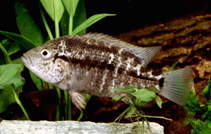| Family: |
Cichlidae (Cichlids), subfamily: Cichlasomatinae |
| Max. size: |
21.5 cm SL (male/unsexed) |
| Environment: |
benthopelagic; freshwater; brackish |
| Distribution: |
Central America: Hispaniola (Haiti and Dominican Republic). |
| Diagnosis: |
|
| Biology: |
Inhabits lakes and streams. Largely found solitarily or in pairs, rarely in groups of 6-8, often in association with poeciliids and the mugilid Agonostomus monticola. Occurs with introduced cichlids at numerous localities. Adults swim in open water, taking refuge in small crevices under debris or in rocks when pursued. Young fish are frequently found in aquatic vegetation. Feeds on algae, other aquatic plants and turret shells. |
| IUCN Red List Status: |
Least Concern (LC); Date assessed: 15 June 2020 Ref. (130435)
|
| Threat to humans: |
harmless |
Source and more info: www.fishbase.org. For personal, classroom, and other internal use only. Not for publication.

